Here is a classic science experiment that reveals bone strength and teaches how vital calcium is in maintaining bone strength!! I.e. “Magic Bending Bone Science Experiment.”
Magic Bending Bone: Vinegar and Chicken Bone Experiment
The magic bone bending science experiment is a great visual demonstration to explore bone science and vinegar’s chemical properties.
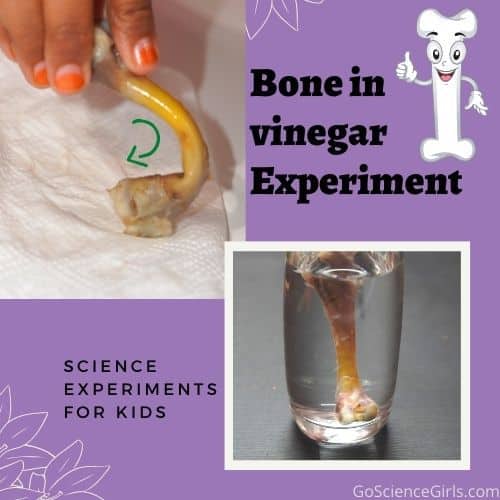
Materials Required
1) You can use the bones left in your meals. Leg bones are perfect for observing the magic bending bone science)
2) A glass bowl or container or jar
3) White Vinegar
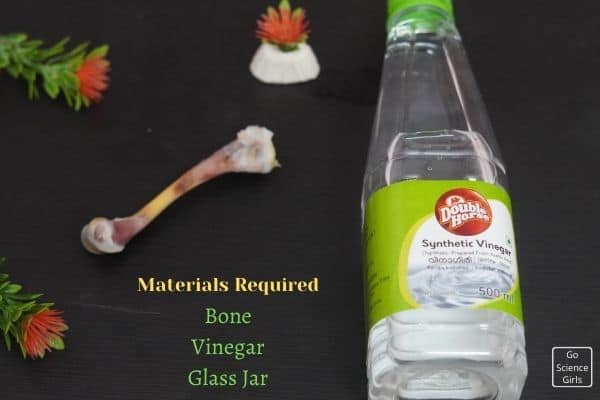
That’s it! Collect these three ingredients on your experiment table, and you are all set to do a bone science investigation.
Instructions to do the Magic Bending Bone Experiment
Step-1:

Take the fresh and dried bone piece and rinse it off again to keep it clean from dirt. And try to bend it carefully with your own hands. As the bones are strong, they do not bend naturally. Calcium is the material we see in the bones of all carnivores that makes bones strong and flexible.
Step-2:
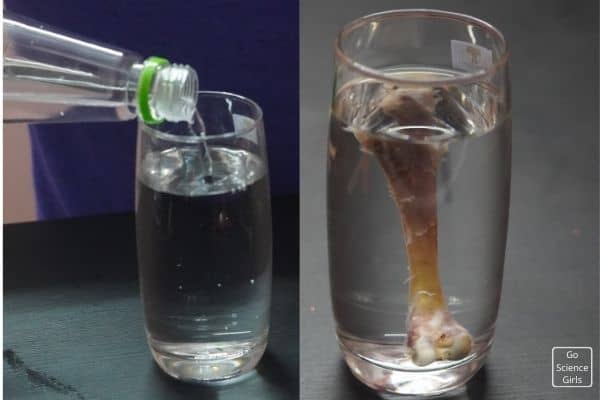
Pick a glass jar or container and fill it with vinegar. Then, put the bone into the jar filled with vinegar. Let the set-up sit for 3-4 days. Close the lid when letting the bone for soaking in vinegar.
Step-3:

After two days of soaking, pour some more fresh vinegar and soak it for more than 1 or 2 days. Always make sure to close the lid during the soaking process.
Step-4:

Once the bone is soaked very well in vinegar for 4-5 days, remove it from the jar and wash it off under regular tap water. Then, let it dry under normal weather conditions.
Step-5:
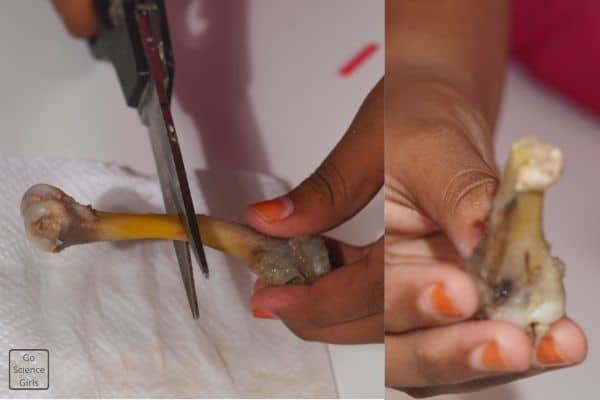
You will notice the bone appearing soft and flexible. Try bending the bone gently without breaking it because as the bone is soft, applying much force may damage it.
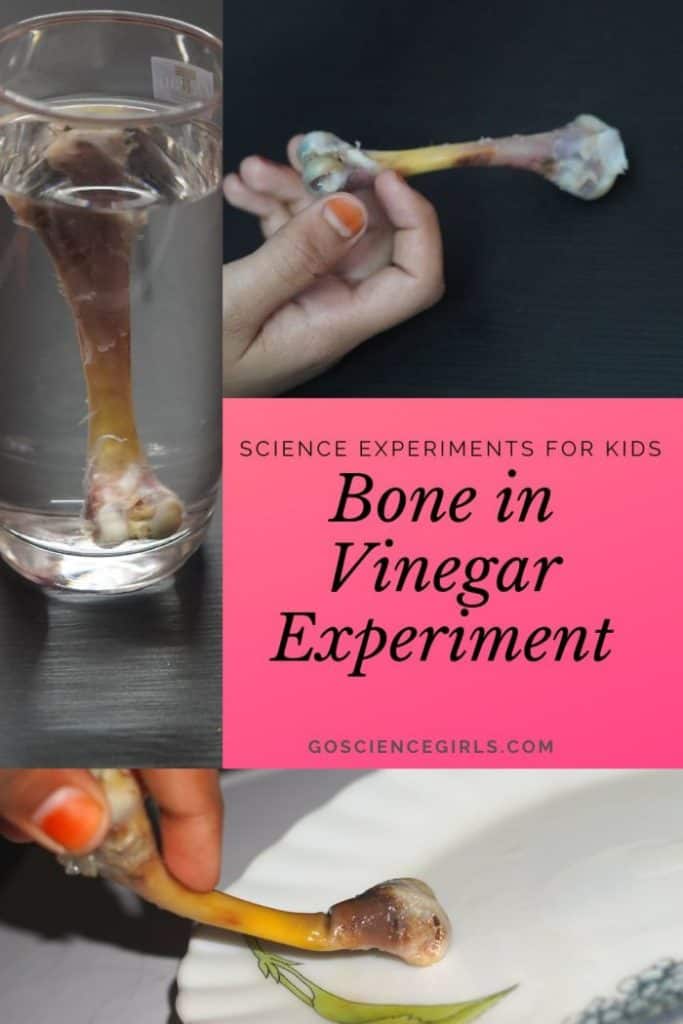
What is the science behind the Magic Bending Bone Experiment?
Naturally, bone formation happens with the combination of calcium carbonate, bone cells, and collagen (soft material).
Bones of any kind of animal, including humans, include the same composition.
When you soak bones in vinegar for 4-5 days, vinegar’s acidic properties start decomposing calcium carbonate and leaves collagen behind.
As collagen is the soft material, we observe bone as soft as a gel when removed from vinegar after soaking for 4-5 days. At this stage, we can even break the bone easily.
We learn how essential is calcium to keep our bones strong through this classic and straightforward experiment. It is how calcium makes bones strong enough to maintain good body movements.
Without calcium, our bones become brittle and soft and are likely to brittle. Also, it isn’t easy to erect a human body posture without enough calcium in the body.
Vinegar is the acidic substance that is strong enough to dissolve calcium carbonate in bones. Once vinegar dissolves all the bones’ calcium, they become soft and brittle as they are only left with weak tissue collagen, which is not strong enough to keep bones hard.
Related Experiment : How Vinegar Dissolves Egg Shell and Produces Rubber Egg
Bending Bone Experiment Worksheets
Here are some informative worksheets that can help children to understand the experiment better. Worksheets help to observe, analyze, ask, and discuss the data collected on the experiment.
https://www.nasa.gov/sites/default/files/heo-cpfc-bendy_bones_seg2.pdf
http://static.lawrencehallofscience.org/diy_human_body/downloads/diy_hb_stiff_bones_bendy_bones.pdf
Teacher’s Guide (Lesson Plan)
Instructions to follow in the Lab
1) Remove the dust or any meat left on the bone and wash it off under regular tap water.
2) Give children the fresh bone and ask them to analyze it regarding its strength, texture, and hardness.
Points to discuss: Report each student’s analysis on the given respective experiment bone in the lab report. Discuss the strength and texture of bones and tell the differences and similarities between human bones and other animal bones. r
Naturally, chicken and human bones resemble the same in regards to texture and composition. It is easy to explain to students about human bones if you choose chicken bones for the experiment.
3) Take the clean glass container and fill it with enough vinegar. Make sure you fill the container up to the brim so that students can immerse the bone completely.
4) Place the bone into the container filled with vinegar. Let the bone soak in vinegar for 4-5 days. Make sure you fill the container with fresh vinegar every alternate day.
5) Observe the changes happening to the bone each day until you remove it from the container. Note down the changes or the analyzed data in the table given below. Each student must contain a table format like below with them to note down their observations.
| Day 2 | ||
| Day 3 | ||
| Day 4 | ||
| Day 5 |
Human Bones and Chicken Bones
Geologists say that chicken bones are the enduring fossil marks for future ages representing the human impact on our planet, Earth.
Anatomically, there are a lot many similarities and differences when we compare both human and chicken bones.
The adaptive mode to flight is the main difference between the birds and human bone structure or skeleton. The bird’s bone structure is hollow, which makes their mode of transport from one place to another place easier as the bones are lighter.
In contrast, the human bone skeleton is a robust framework with 270 bones for the movement from one place to another, i.e., walking.
Flying is the bird’s mode of action and walking is the human’s primary mode of activity. So, based on the movement mode from place to place, both human and bird bone skeleton differs.
However, there are a lot many similarities too in the bone structure of human and bird skeleton. That is the composition of bone material.
Calcium carbonate and soft tissue, i.e., collagen, is the main component of bone structure in humans and chickens. That is why we use chicken bones in the Bending Bone Science Experiment instead of human bones, as chicken bones are good enough to represent human bones.
For example, vinegar makes chicken bones softer and even brittle when exposed to a long-hour vinegar solution. Vinegar has acidic properties to dissolve calcium carbonate in bones and leaves the only collagen which is not strong enough to keep bones strong.
Similarly, when human bones are constantly exposed to acidic solutions like cola and other acidic drinks or food, the acidic contents dissolve calcium content. Thus making the bones brittle and rubbery, which is known as a disease, Osteoporosis.
FAQ
Yes, Vinegar is known as milk acid, but it is strong enough to dissolve bones’ calcium. Slowly, it decomposes all the calcium content in the bones and leaves the bone with soft tissue collagen.
As collagen is a soft tissue, it does not support bone anymore to stay hard and strong. Hence, the bone becomes weak when you dissolve it in vinegar for longer times.
Absolutely Yes, Vinegar dissolves all the calcium content in bones slowly and gradually. All you need to do is immerse a chicken bone in the bowl filled with vinegar.
Let it sit for 4-5 days in vinegar without disturbing. After 5 days, remove the bone from the bowl and observe. You will notice the bone becomes soft and is more likely to bend.
When you immerse a chicken bone in vinegar solution, the acidic properties start dissolving calcium in the bones.
As we let the bone sit in vinegar solution for 4-5 days, it is enough time for vinegar to dissolve all the calcium in the bones. It was eventually making the bones softer and rubbery.
Studies say that coke is composed of phosphorous and caffeine which helps it to do carbonation.
Carbonation is the formation of bicarbonates, carbonates, and carbonic acid that happens when carbon dioxide reacts chemically. So, when you soak bones in coke for more extended periods, they become softer and tend to bend in any direction like rubber.
Because caffeine and phosphorous exists, carbonation and decomposition begin in bones’ calcium. However, the softer bone gets back to its original rigid state when you leave it under the sun until dry.
It, Brittles! Yes, when you soak a chicken bone in bleach for few days, the chemical properties of bleach decompose all the organic substance of the bone. In this process, the bones remain with only calcium material which is a white and brittle material.
Calcium as a natural substance cannot make a substance hard; instead makes it brittle. That is why a chicken bone brittles and even breaks completely when soaked in bleach for a more extended period.
Researchers say that large doses of vinegar can leach the calcium from bones gradually. They also stated that on prolonged exposure to vinegar, there is no formation of new bones.
Because vinegar is acidic and has enough capability to leach calcium and makes it softer. Just put the one in vinegar solution and leave it for 3-4 days.
And observe the bone of each bone since you drop it in vinegar and even after removing it from the vinegar solution. The bone is more likely to bend at this stage and feel like rubber.
Calcium, collagen, and other minerals make human and animal bones hard and stronger. They also help in the formation of new bones. Hence, doctors suggest that humans consume more calcium-rich foods for new bone formation and support the existing bones.
Human and animal bones resemble the same in bone texture, strength, and hardness. Hence, we use chicken bones in place of human bones.
However, bones lose calcium and become soluble because of the acidic properties of vinegar. Such that it is easy for vinegar water molecules to decompose calcium from bones. They were finally making bones less strong, rigid, rubbery, and more likely to bend.
No!! Vinegar does not break down calcium, but it can dissolve it. When you put a chicken bone in vinegar for 3-4 days, vinegar’s acidic properties dissolve vinegar.
And leave the bone with soft tissue called collagen, which is not good enough to keep the bone strong and rigid. Thus, vinegar makes rigid bone a softer and bending bone.
Brittle bone is a genetically transferred disease from one generation to the next generation through families. It is a genetic disorder where there is no formation of collagen, a soft tissue in the bones that helps to form bones and maintains its strength.
When there is no enough collagen in your bones, they become soft and more likely to bend. Sometimes, we can easily break the bones that are in lack collagen. That means the bones become brittle without collagen. Hence, collagen is the primary substance that is damaged in brittle bone.
The softest bone in the human body is cartilage, i.e., Tongue. Yes, the Tongue itself contains a soft bone that doesn’t seem like a bone. So, humans generally ignore to consider the Tongue has a bone.
The Tongue is the most crucial organ in the gustatory system used to sense taste. It contains pink and moist soft tissue known as the mucosa, on which there are many taste buds. The coarse texture of the Tongue of vertebrates is due to papillae, tiny bumps on the Tongue.
